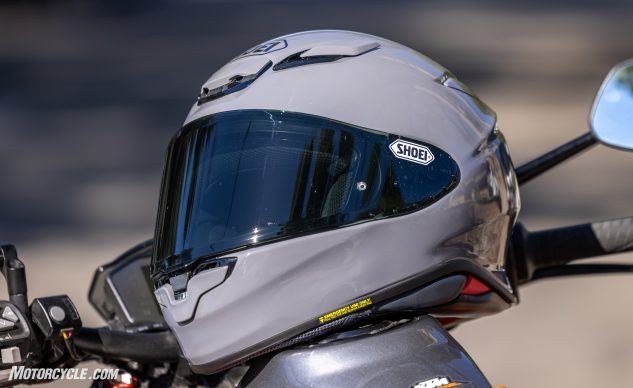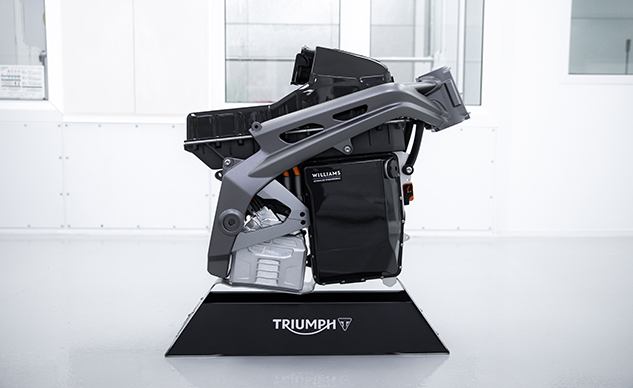Shoei has produced motorcycle helmets since 1958. More than 30 years after Shoei’s first helmets made their way into the marketplace, I bought my first Shoei, an RF-200, during the initial year of it’s production in 1989. Before the end of its production cycle in 1995, thanks to saving me in one crash, I owned a couple of them. Since that time, I have owned at least one of every single RF model that Shoei produced. To say that I am a fan of the model line would be an understatement. A Shoei RF helmet was my most worn line of helmet until the Neotec convinced me that it was the perfect helmet for daily around town rides. Still, on most sporting rides, where I’d don a non-modular helmet, the RF-1200 was still at the top of my list. After living with the newest version for about a month, the Shoei RF-1400 continues that trend with its further refinement of the company’s popular and versatile helmet.
The first thing to consider with an established – and popular – model helmet , like the RF-1200, is that Shoei didn’t need to create a new helmet out of whole cloth. Instead, Shoei presents the RF-1400 as a refinement of its predecessor. In the press documents delivered with the helmet, the concept of kaizen, a Japanese term for “continuous improvement,” is referenced, and anyone who is familiar with the RF-1200 can immediately see the heritage in the RF-1400’s profile. Still, through extensive use of Shoei’s in-house wind tunnel, the RF-1400 manages a 6% reduction in lift and a 4% reduction in drag when compared to its elder sibling.
This improved slipperiness affects the rider in two key areas. First, rider fatigue is reduced thanks to the lessened force placed on their head. By slicing through the air more efficiently, the helmet saves the rider effort, whether simply holding the helmet steady or rotating their head to check a blind spot. This improved aerodynamics also affects the quietness of the helmet’s interior. With less turbulence around the helmet, important noises, such as traffic sounds, are easier to hear over the diminished background noise.
Since the visor is a place where noise can be generated, this was a major focus of the RF-1400’s update. The vortex generators on the trailing edge of the visor were borrowed from the X-Fourteen and help the air flow more quietly past the sides of the helmet. The new CWR-F2 shield mates to a newly designed base plate system, which Shoei claims allows for smoother opening and closing. Additionally, the first notch on the visor is a new vent position that allows for quick de-fogging.

The redesigned chin vent is easy to open with a gloved hand, and it wraps around the new, centrally-located visor release button.
Now would be the time to point out what is perhaps the RF’s biggest change for the user. The visor latch is centrally located instead of on the left side. Yes, if you’ve upgraded from an RF-1200, as I did, you’ll have to contend with some muscle memory for a bit (while also shedding a tear for any extra visors you may own for the RF-1200 since they won’t fit), but Shoei’s reasoning for moving the latch is sound. The new location allows for opening and closing forces to be evenly distributed between the spring-loaded base plates for more uniform opening/closing effort and a tighter seal. Since the eye port opening is a source of both wind, weather, and noise ingress into the helmet, the beading that seals the visor interface was redesigned and even features dual drains on the outer bottom edges. Finally, the standard clear shield comes with Pinlock posts, and a Pinlock visor is included with the helmet.

The redesigned base plate pairs with the new beading to keep out wind and weather, for a quieter, drier ride. Note the notch for the drain on the bottom beading.
Another visually apparent change to the RF-1400 is the ventilation system. The center forehead vent has an additional hole and a much less fidgety slider that is easier to manipulate with gloves. The two side vents remain the same, but the exhaust outlets were enlarged to allow the negative pressure behind the helmet to better draw out hot air. In total, the RF-1400 has six intake vents and four exhausts while not negatively impacting the interior noise level.
The quietness of the RF-1400 bears mentioning. Previously, when comparing helmet noise among different helmets, the RF-1200 has always been my standard by which I compared all other helmets I’ve tested. Well, with the vents closed, the RF-1200 is no longer the champion. The RF-1400 has stepped in to take its place in side-by-side tests. One key area for noise to penetrate the sanctity of the helmet interior is the large hole required to insert the rider’s head. When donning the RF-1400, the initial slide into the interior is just a smidge tighter before your head pops into the ergonomically-shaped interior. (Well, at least for folks with a medium-to-long oval head, that is.) The redesigned cheek pads assist with the snug-but-comfortable fit. Also, installing the included chin curtain helps to mute outside noise at speed.

The forehead center vent now has two ports to allow air in to cool the rider. The shape of the vent makes it much easier to open/close with a gloved hand.
Although I would never recommend riding any real distance without earplugs, I have found myself riding without them more around town than I typically do – even when that ride includes a quick blast of a couple of exits on the freeway. On warmer days, with the vents open, you’ll still want plugs, but the noise level is still lower than before. When it comes to ventilation, the RF-1400 follows its predecessor. Airflow is good but not class-leading, which I think is a conscious choice. My best venting helmets tend to be noisier, and one of Shoei’s stated goals for the RF-1400 was noise reduction.

Much of the credit for the RF-1400’s improved quietness must go to the snugger bottom opening. Once the rider’s head is in the pads wrap themselves comfortably around the rider’s head.
With the key changes to the RF-1400 noted above, I’d be remiss if I didn’t point out a few features that make Shoei one of the premium helmet manufacturers. First are the protective qualities, which combine to make – at 3.65 lb. – the lightest Snell-approved helmet in Shoei’s line. The Multi-Ply Matrix AIM+ Shell construction utilizes a six-ply matrix of fiberglass with lightweight organic and high-performance fibers to create a strong-yet-elastic protective layer. Following the shell, Shoei’s Dual-Layer, Multi-Density EPS liner varies the foam density to absorb impacts while still allowing for channels that flow cooling air. Finally, there is the removable, washable, adjustable, and replaceable 3D Max-Dry Interior System II, which is responsible for much of the RF-1400’s comfortable, premium fit.
In summary, the Shoei RF-1400 is a great update to its predecessor, the RF-1200, and provides iterative changes to all of the features that make the RF line so popular. You’ll find everyone from touring riders to cruiser riders to track day jockeys wearing the RF-1200, and I expect the same from the RF-1400. In just a month, the RF-1400 has already made it to the top of the list of helmets I reach for when I go for a ride.
The Shoei RF-1400 is available at retailers, starting January 1, 2021, and is priced at $500 for solid colors and $600 for graphics.
Source link





